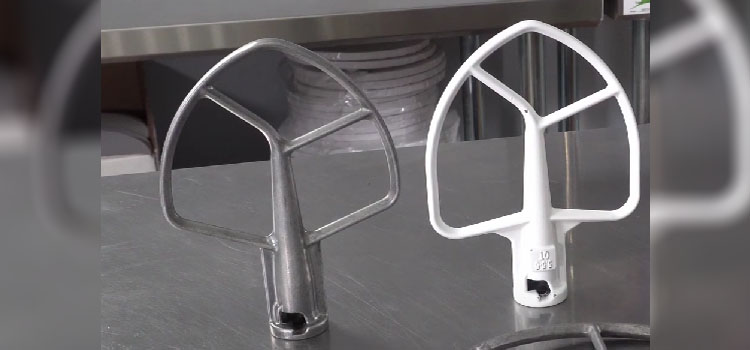Last Updated on July 21, 2024 by Lori Walker
Choosing the **perfect KitchenAid attachment** adds that special touch to your frosting, making it creamy and luxuriously delightful—like a sweet dance party for your taste buds.
So which KitchenAid attachment should you use for frosting?
Drawing from my own experiences in the kitchen, I am here to guide you toward the ideal attachment that will effortlessly whip up dreamy frosting, ensuring your cakes and treats are baked with perfection.
What Is The Recommended KitchenAid Attachment For Frosting?

The recommended KitchenAid attachment for frosting is the flat beater.
While the whisk attachment is commonly used for light and airy frostings, the flat beater is ideal for denser frostings, such as cream cheese or ganache [1].
Its design helps blend and smooth out the ingredients, creating a creamy and velvety texture that spreads beautifully on your cakes and treats.
But what’s the recommended KitchenAid attachment for baking cakes?
What Makes The Flat Beater Attachment Ideal For Frosting?
The flat beater attachment is the perfect choice for frosting due to its versatile design and functionality.
Its flat, paddle-like shape effortlessly blends and smooths out the frosting ingredients, resulting in a creamy and velvety texture.
“I’m addicted to food, so if you bring the cake and stuff to my house, I might walk by and take a swipe of icing and keep it moving. So what happens is I try not to keep it around.”
– Fat Joe, American Rapper
The flat beater is particularly well-suited for denser frostings, such as cream cheese or ganache, requiring a lighter touch than the whisk attachment.
It works diligently to incorporate all the ingredients evenly, eliminating lumps and creating a smooth consistency that spreads beautifully on cakes and treats.
Read: Is KitchenAid Mixer Tilt Head Better Than Bowl Lift?
Other Attachments Suitable For Frosting

- Whisk Attachment: The whisk attachment is perfect for creating light and fluffy frostings, especially for whipped cream, meringue [2], or buttercream frostings that require aeration. It incorporates air into the mixture, resulting in a delightful texture.
- Flex Edge Beater Attachment: The flex edge beater attachment features a flexible scraping edge that works well for scraping down the sides of the bowl and ensuring all the ingredients are thoroughly mixed. While it may not incorporate as much air, it helps achieve a smooth consistency for certain frostings.
- Wire Whip Attachment: The wire whip attachment, similar to the whisk attachment, is ideal for incorporating air into frostings and achieving a light and fluffy texture. It can be used for frostings that require aeration or when you want to create a whipped texture.
- Pouring Shield Attachment: While not directly involved in the frosting process, the pouring shield attachment can be helpful to prevent splattering and keep the workspace clean while adding ingredients to your frosting mixture.
“Like a symphony conductor, the right KitchenAid attachment orchestrates the dance of ingredients, transforming them into velvety swirls of frosting perfection.”
– Leonelli Bakery
Find out the difference between KitchenAid Classic and Deluxe Stand Mixers here.
Tips For Achieving The Perfect Frosting Consistency
- Gradual Mixing: Mix your frosting ingredients at a low speed and gradually increase the speed to prevent splattering and ensure even incorporation. This gradual process helps achieve a smooth consistency without any lumps.
- Softened Ingredients: Ensure your butter or cream cheese is softened at room temperature before mixing. Softened ingredients blend more efficiently, resulting in a smoother and more cohesive frosting.
- Sifting Dry Ingredients: If your frosting recipe calls for powdered sugar or cocoa powder, sift them before adding them to the mixing bowl. This step helps eliminate any lumps, ensuring a silky-smooth frosting.
- Adjusting Consistency: Gradually add liquid ingredients (such as milk or cream) to achieve the perfect frosting consistency. Start with a smaller amount and add more to achieve the desired texture. If the frosting is too thin, add the powdered sugar a little at a time to thicken it. Wash the frosting for a bit longer for a softer and fluffier texture.
- Chill and Rest: If your frosting feels too soft or runny, briefly place it in the refrigerator to firm up slightly. Chilling helps the fats in the frosting solidify, resulting in a more stable consistency. Additionally, allowing the frosting to rest for a few minutes before using it can help it set and become easier to spread.
Also Read: Simple Steps In Removing A Bowl From The KitchenAid Mixer
FAQs
Which KitchenAid attachment to use for buttercream frosting?
The recommended KitchenAid attachment for buttercream frosting is the paddle attachment.
Which KitchenAid attachment to whip butter?
The recommended KitchenAid attachment to whip butter is the wire whip attachment. But which KitchenAid attachment to use for mashed potatoes?
In Conclusion
Selecting the proper KitchenAid attachment for frosting is critical to achieving smooth and delectable results.
While the paddle attachment is ideal for denser frostings like cream cheese or ganache, the whisk attachment works wonders for lighter and airier frostings like whipped cream or buttercream.
The flexibility of using different attachments allows you to tailor the consistency and texture of your frostings to suit each unique recipe.
Experimenting and finding the perfect attachment for each type of frosting will elevate your creations, ensuring they are visually stunning and irresistibly delicious.
References:
- https://www.allrecipes.com/recipe/33647/chocolate-ganache/
- https://www.bbcgoodfood.com/recipes/ultimate-meringue
- How to Store Krispy Kreme Donuts To Keep Them Fresh Longer - July 23, 2024
- How to Make Frosting with Granulated Sugar: A Simple Guide - July 22, 2024
- What Happens to Bakery Waste? - July 22, 2024
